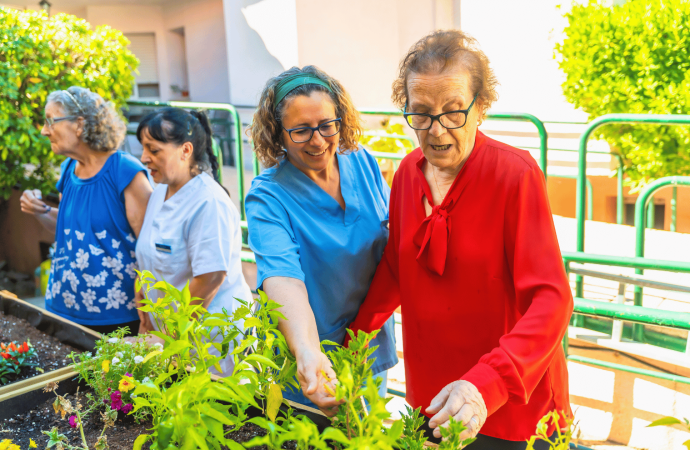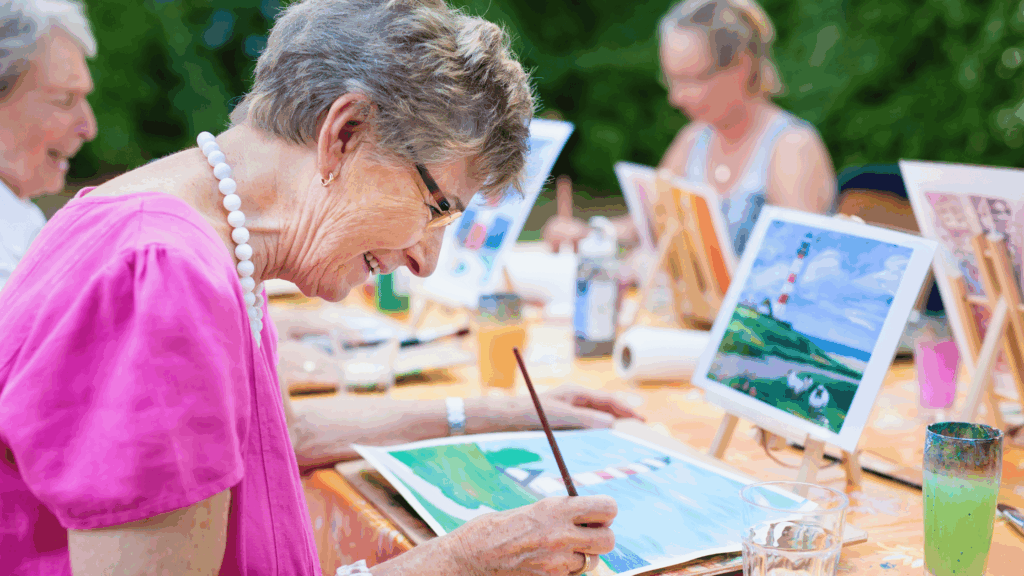Spring Gardening &
Assisted Living Communities
As the days lengthen and the air warms, the vibrant energy of spring breathes new life into our surroundings. For assisted living communities, this season presents a unique opportunity to engage residents in the rejuvenating activity of gardening. Spring gardening is more than just planting flowers; it’s a therapeutic, social, and sensory experience that can significantly enhance the well-being of seniors.
The Therapeutic Power of Gardening in Assisted Living
Gardening has long been recognized for its therapeutic benefits. It offers a gentle form of physical activity, mental stimulation, and emotional fulfillment. For residents in assisted living, these benefits are particularly profound.
- Physical Health: Gentle gardening tasks like planting, weeding, and watering help improve motor skills, flexibility, and strength. The act of being outdoors also provides exposure to sunlight, crucial for vitamin D production and overall health.
- Mental Well-being: Gardening provides a sense of purpose and accomplishment. It can reduce stress, anxiety, and depression by fostering a connection with nature and providing a calming, meditative experience. The sensory stimulation from the sights, smells, and textures of plants can also enhance cognitive function and memory.
- Emotional Fulfillment: Nurturing plants and watching them grow provides a sense of accomplishment and connection. It can boost self-esteem and create a sense of belonging within the community. For those in assisted living, this can be particularly important in combating feelings of isolation.
Creating Accessible Gardens for Assisted Living Communities
To ensure that all residents can participate in spring gardening, it’s crucial to create accessible garden spaces.
- Raised Garden Beds: Raised garden beds are essential for residents with mobility limitations. They reduce the need for bending and kneeling, making gardening more comfortable and accessible.
- Accessible Pathways: Wide, smooth pathways are necessary for residents using wheelchairs or walkers. Ensure that pathways are free of obstacles and provide adequate space for maneuverability.
- Ergonomic Tools: Lightweight, ergonomic gardening tools with comfortable grips can make gardening easier and more enjoyable for seniors. Consider tools with extended handles to minimize bending.
- Sensory Gardens: Incorporate plants with diverse textures, scents, and colors to create a stimulating sensory experience. Include fragrant herbs like lavender and rosemary, soft-textured plants like lamb’s ear, and brightly colored flowers.
- Vertical Gardens: Vertical gardens are excellent for maximizing space and accessibility. They can be installed at varying heights, making it easy for residents to reach and tend to plants.

Choosing the Right Plants for Spring Gardening in Assisted Living
Selecting the right plants is crucial for a successful and enjoyable gardening experience. Consider these factors when choosing plants for your assisted living community:
- Low Maintenance: Choose plants that are easy to care for and require minimal maintenance.
- Sensory Appeal: Select plants with vibrant colors, fragrant scents, and interesting textures.
- Safety: Avoid plants with thorns, poisonous berries, or allergens.
- Local Climate: Choose plants that thrive in your local climate and are suitable for the spring season.
- Resident Preferences: Involve residents in the plant selection process to ensure that their preferences are considered.
Some excellent choices for spring gardening in assisted living communities include:
- Flowers: Pansies, daffodils, tulips, primroses, and snapdragons.
- Herbs: Basil, mint, chives, parsley, and thyme.
- Vegetables: Lettuce, radishes, spinach, and peas.
The Importance of Sun Safety in Spring Gardening
While the sun is beneficial, it’s important to practice sun safety when gardening.
- Sunscreen: Encourage residents to wear sunscreen with an SPF of 30 or higher.
- Hats and Protective Clothing: Provide wide-brimmed hats and lightweight, long-sleeved clothing to protect residents from the sun.
- Hydration: Ensure that residents stay hydrated by providing plenty of water.
- Shade: Create shaded areas in the garden where residents can take breaks from the sun.
- Timing: Schedule gardening activities during the cooler parts of the day, such as early morning or late afternoon.
Spring Gardening and Cognitive Stimulation in Assisted Living
Gardening provides excellent cognitive stimulation for seniors in assisted living.
- Planning and Decision-Making: Residents can participate in planning the garden, choosing plants, and deciding where to plant them.
- Problem-Solving: Residents can learn to identify and address common gardening problems, such as pests and diseases.
- Memory and Recall: Residents can share their gardening knowledge and experiences, recalling past gardening projects and techniques.
- Sensory Engagement: The diverse sensory experiences of gardening can stimulate cognitive function and memory.
Adapting Gardening Activities for Residents with Cognitive Impairments
For residents with cognitive impairments, it’s important to adapt gardening activities to their abilities.
- Simple Tasks: Break down gardening tasks into simple, manageable steps.
- Visual Cues: Use visual cues, such as pictures and labels, to guide residents through gardening tasks.
- Hands-On Assistance: Provide hands-on assistance and support as needed.
- Sensory Stimulation: Focus on sensory activities, such as touching fragrant herbs and feeling different textures of plants.
- Familiar Plants: Use familiar plants and flowers that residents may recognize.
Final Tips for a Successful Spring Garden in Assisted Living
- Start Small: Begin with a small garden and gradually expand as residents become more comfortable and engaged.
- Involve Residents: Involve residents in all aspects of the gardening process, from planning to harvesting.
- Provide Support: Provide ongoing support and assistance to residents as needed.
- Celebrate Successes: Celebrate the successes of the garden and recognize the contributions of residents.
- Document the Journey: Take photos and videos of the garden and its progress. This can create a lasting memory and provide a sense of accomplishment.
Conclusion
Spring gardening in assisted living communities offers a wealth of benefits, from improved physical and mental health to enhanced social connections and cognitive stimulation. By creating accessible garden spaces, choosing appropriate plants, and fostering community spirit, you can cultivate joy and well-being among your residents.
We encourage you to embrace the rejuvenating power of spring gardening and create a vibrant and engaging experience for your assisted living community. Contact us today to learn more about how we can help you create a thriving garden that benefits your residents.
Latest Blogs
The Importance of Male Friendships in Senior Communities
Moving into an assisted living community represents a significant life transition. While…
Maintaining Mental Wellness in Assisted Living
Moving into an assisted living community represents a significant life transition. While…
Strategies for Supporting a Loved One with Dementia or Alzheimer’s
Dementia and Alzheimer's disease present unique challenges, not only for the individuals…



